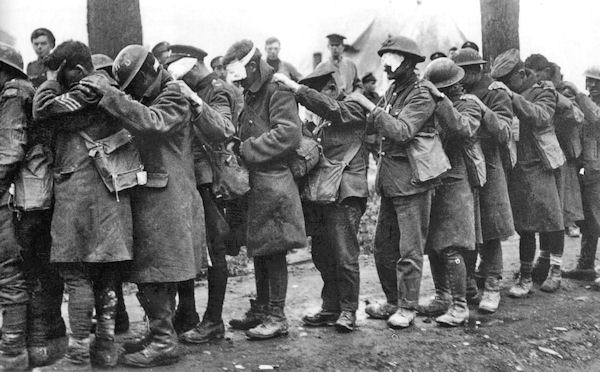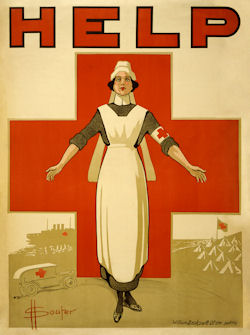The Casualties of War
Casualties were expected, of course, but on nothing like the scale which materialised. Nor was anyone prepared in any way for the range of war wounds – blindness, effects of gassing, loss of limbs, to say nothing of more conventional wound trauma - however, Britain adapted to meeting the needs of the wounded far more quickly than any other aspect of its early conduct of the war. This was particularly true on the home front and it was largely due to the efforts of the women who were left behind.

Right from the outset local committees were set up to address a whole range of a soldier and his family’s welfare needs. Most of these were local branches of national organisation such as The Soldiers & Sailors Families Association which has already been mentioned. Its role was to help and support soldiers’ and sailors’ families. The Vale of Leven Distress Committee performed a similar role but also helped others in the wider community who had been adversely affected by the war.
After 1916 there was an all-male organisation called the Vale of Leven Discharged Sailors & Soldiers Society, which was open to anyone who had served in the forces for even a day and was one of the forerunners of the British Legion. There was also a local branch of the Voluntary Aid Detachment which had been formed in 1907, which consisted of young women who volunteered to assist in emergency hospitals at home and abroad. And of course there was the local branch of the Red Cross which was the main medical support unit for the forces away from the front-line.
In most of these organisations in the Vale, men may have been the titular branch chairman but it was the women who did most of the work. This ranged from fund raising through to nursing the wounded and invalided soldiers. This is hardly surprising since from the outset of the war women had by far the firmer grip on reality on what was going to be needed to support the wounded both at the front and back home. There were women who were enthusiastic supporters of the war and got carried along by the patriotic fervour in the early days, but by and large both they and others considerably less enthusiastic about the war, could see all the problems ahead and planned accordingly.
Local Hospitals
At the outbreak of the war there was no hospital in the Vale of any sort and no hospital which could deal with wounded soldiers in Dumbarton. In the first week or so of the war William Gilmour Ewing and his wife offered the Gilmour Institute, the Scottish Girls Friendly Society and the Jessamine Convalescent Home at Croftamie to the Dumbartonshire branch of the British Red Cross Society for use as hospitals.
By December 1914 some of the ladies who lived in the big houses in the locality had offered to provide accommodation for wounded soldiers, and gathered teams of women around them from the Lochside and the Vale to help out. The first to make this offer was Mrs Chrystal of Auchendennan House, who with her husband offered to convert Auchendennan Home Farm to a hospital for soldiers wounded at the front. Considering that casualties at this time were relatively modest in comparison with what was to come in the next 4 years, these were all highly practical offers but none of them seem to have been taken up and it’s not clear why.
 As it turned out, the only local hospital for wounded soldiers during most of WW1 was the Auxiliary Red Cross Hospital in Dumbarton. It was opened in January 1915 in Dumbarton’s United Free High Church Mission Hall, and with an extension to the Cottage Hospital it could accommodate 25 beds. It eventually moved to the Parish Church Hall, which could house 63 beds and this move reflected the hugely-increased needs of the war of attrition on the western front.
As it turned out, the only local hospital for wounded soldiers during most of WW1 was the Auxiliary Red Cross Hospital in Dumbarton. It was opened in January 1915 in Dumbarton’s United Free High Church Mission Hall, and with an extension to the Cottage Hospital it could accommodate 25 beds. It eventually moved to the Parish Church Hall, which could house 63 beds and this move reflected the hugely-increased needs of the war of attrition on the western front.
It remained there until its closure in December 1918 after the war’s end. Although the Hospital was located in Dumbarton a major part of its support came from the Vale as well as other parts of western Dumbartonshire. This included fund-raising, growing vegetables for the kitchens, knitting and donations of socks, books etc.
Almost as soon as a wounded soldier was fit to do so he was sent home from hospital and his family had to take charge of his recuperation and recovery. Thus at any one time from the end of 1914 onwards there were a great many wounded soldiers in the Vale and the full horrors of the war were known to one and all.
The illusions of August 1914 about “giving the Boche a jolly good hiding” or having a great adventure as part of some extended holiday or most haunting of all “the war will be over by Christmas” soon disappeared, to be replaced by an altogether more sombre mood both amongst the soldiers and the public back home.


